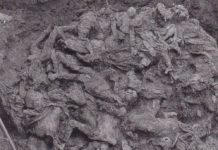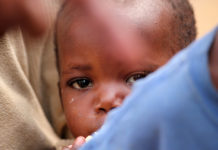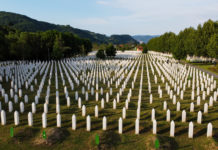The Silent Genocide is the name given to the Guatemalan genocide of an estimated 200,000 Mayan people in Guatemala. In addition to the 200,000 deaths, another 200,000 became refugees when they fled Guatemala for Mexico to escape the violence. Another million Mayan people became internally displaced.
Like many of history’s genocides that we have looked at in articles on this website and our podcast series on the history of genocide, Never Again, Again, Guatemala’s Silent Genocide took place in the background of a broader war that spanned decades. Historically, ongoing war has served as the cover for mass atrocities, ethnic cleansing, and genocide. That historical fact holds from the Armenians to Srebrenica and beyond. The historical facts of Guatemala’s Silent Genocide often get overlooked in the wider story of Guatemala’s Civil War.
Guatemala’s Background – Prelude to the Mayan Genocide
The history of Guatemala, and indeed Central America, is one of constant tragedy. Those tragedies seem to accelerate every time foreign powers intervene in the region. The Mayan people are historically the greatest victims of those tragedies.
Learn more about the true causes of dysfunction in Latin America’s history through this blog series – Why Is Latin America So Dysfunctional?

In 1951, the democratically elected Jacobo Arbenz came to power. Arbenz’s left-leaning policies included plans to nationalize the exploitive United Fruit Company, a US-based corporation that pilfered Latin America for decades.
While serving the best interests of Guatemala, Arbenz’s policies positioned him as a threat to US Cold War policies. Leaders in the US government viewed Arbenz’s rule in Guatemala as an inroad for communism in the western hemisphere. To that end, the US orchestrated a coup in 1954 that overthrew Arbenz. A series of coups followed in Guatemala.
Each new coup fostered increasing instability as the nation’s institutions crumbled and Guatemala drifted toward civil war.
The most significant suffering of this period fell upon Guatemala’s poor and indigenous populations. The indigenous people of Guatemala, particularly the Maya, made up more than half the country’s population but held no land. They endured generations of discriminatory policies and laws.
The Mayan people are the only indigenous population that constitutes a majority of Guatemala’s population. Today there are 21 different Mayan communities in Guatemala that makeup 51% of the country.
As their suffering increased under different military regimes following the overthrow of Arbenz, nothing increased the appeal of communism to these disenfranchised groups as the behavior of the hardline military rulers who were often backed by US foreign policy, military, and dollars.
As military rulers dealt out oppression and hopelessness, the ranks of leftist organizations in Guatemala grew.
The Civil War in Guatemala
By 1960 government corruption in Guatemala was observed at an all-time high. The US backed military ruler allowed US troops to train for their upcoming Bay of Pigs invasion of Cuba on Guatemala’s soil.
Many military members felt the government’s toleration of US troops training in Guatemala violated the country’s sovereignty. A small group of leftist military officers attempted to overthrow the government at that time but failed. The failed coup served as the impetus for Guatemala’s Civil War that continued for the next 36 years.
The US bombed bases belonging to the officers behind the failed coup, and a newly organized insurgency resulted. Over the years, the insurgency leaned more and more on Fidel Castro and communist Cuba for support. Meanwhile, the insurgency served as evidence of the communist threat in Central America for many US policymakers. Thus, the continued US support for increasingly brutal and oppressive regimes in Guatemala became assured.
State terror became a key feature of the government’s strategy in Guatemala’s Civil War. The government’s military intelligence units began to invade homes of suspected leftists and leftist sympathizers. Once arrested, the ranks of the “disappeared” began to mount.
-
- The Guatemalan Human Rights Commission estimated 20,000 Guatemalans were killed or “disappeared” between 1970-74.
- Amnesty International called Guatemala a human rights state of emergency in 1973
Meanwhile, leftist guerillas began to target government officials in Guatemala City for assassination. In 1968 the United States ambassador to Guatemala was assassinated.
In the early 1970s, the guerilla insurgency became more tightly linked to Guatemala’s rural and poverty-stricken areas. New guerilla organizations held close ties and support of the country’s rural poor. They defined themselves as protectors of the poor of Guatemala. As their violence against the members of Guatemala’s elite and wealthy intensified, so did the government’s response against Guatemala’s poor and rural areas.
Guatemalan government sponsored death squads targeted individuals and groups perceived as leftist. Often included among the groups perceived as leftist sympathizers were Catholic priests. Meanwhile, leftist terrorists targeted military members suspected to be participants in the death squads for assassination.
The tit-for-tat cycle of violence between the two sides intensified so that by the early 1980s, average Guatemalan citizens lived in constant fear of kidnapping, murder, or disappearance.
Many of the country’s poor now supported the insurgency, either willingly or by coercion from guerillas.
Targeting the Mayans
Targeting the Mayan people became commonplace in the mid-1970s and ramped up until 1984. The Mayans carried a historical legacy of disenfranchisement and discrimination from the elites of Guatemala’s history.

The association of the Mayan people to leftist sympathizers, while likely based upon some levels of fact, was also easily achieved in the imagination of the establishment in Guatemala. The average Guatemalan already associated the Mayan people with poverty and weakness. In other words, because the Mayans were the perfect people to find the ideals of communist guerillas appealing, they became the ideal targets for government sponsored violence when the push against the insurgency accelerated.
Efrain Rios Montt and the Guatemala Genocide
Guatemala’s civil war endured for 36 years, but the darkest days of that war included the 14 months of rule under Efrain Rios Montt between 1982 and 83. This is the era of the Silent Genocide (also called the Mayan Genocide or the Guatemala Genocide).

Montt came to power through a coup in 1982. He implemented a series of bloody suppressions against other military members, which Montt suspected as capable of a counter-coup. Montt described himself as a protestant pastor, and upon assuming office, he gave a speech in which he said his ascent to power was the “will of God.”
To retake the countryside, Montt formed civilian defense patrols where as many as 1 million conscripts participated in expelling guerillas out of the country’s rural areas. Membership in these civilian defense patrols was technically voluntary, but failure to volunteer presented a strong suggestion that a person sympathized with the insurgents and thus put their lives in danger. More often than not, the targets of these civilian defense patrols were the Mayan people.
-
- Between 1982 and 1983, at least 440 Mayan villages were destroyed
- At least 200,000 children lost at least one parent
- Children were often targeted in the massacres
- More than 620 massacres were carried out against Mayan peasants during the conflict
- Rape and torture often preceded death for the victims
The Silent Genocide and the Failure of Justice
In 1994 the government of Guatemala established a Historical Clarification Commission that found more than 200,000 people killed or disappeared during the Guatemala Civil War. Among these victims, 93% were the result of actions by government and paramilitary forces. Additionally, 83% of the identified victims were Mayan.

Montt was overthrown in a coup in 1983. The killing did not stop immediately, but the targeted violence against the Mayan people subsided. In 1996 the civil war in Guatemala came to an end.

In May 2013, Montt was found guilty of genocide and crimes against humanity. The verdict was quickly overturned through a series of appeals from Montt’s attorneys. A new trial against Montt, now suffering from dementia, began in 2017, but Efrain Rios Montt died in April. Like many of the histories of genocide, the victims of the Silent Genocide feel they never received justice.










